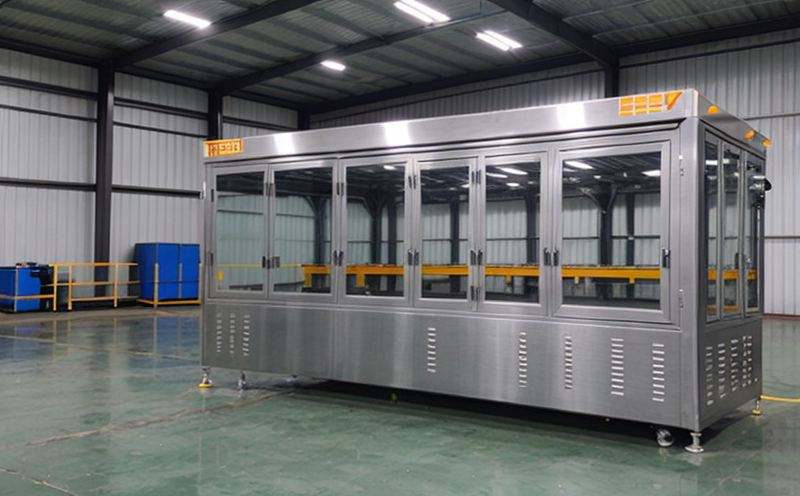ASTM E1823 Fracture Toughness of Metals
The ASTM E1823 standard provides a method for determining the fracture toughness (KIc) of metals, including steels and other alloys. This test is critical in assessing the resistance of materials to crack propagation under stress, which is particularly important for metal packaging used in industries such as food, beverage, pharmaceuticals, and chemical products.
The ASTM E1823 procedure involves subjecting a notched specimen to static loading until failure occurs. The fracture toughness is calculated using the energy release rate (G) from this process. This service is essential for ensuring that metal packaging materials meet stringent safety and performance criteria without compromising on strength or durability.
The test is performed in accordance with ASTM E1823-18, which specifies the procedures for notched beam testing of metals under static loading conditions. Compliance with these standards ensures consistent results across different laboratories and industries worldwide.
For accurate determination of KIc, proper specimen preparation is crucial. Specimens must be machined to precise dimensions as outlined in ASTM E1823, ensuring that the notch geometry and size are within specified tolerances. This precision ensures reliable data interpretation.
The testing equipment typically includes a universal testing machine capable of applying controlled loads with high accuracy. The machine is equipped with a video extensometer for measuring strain accurately during the test. Other accessories like grips or fixtures may also be required depending on the type and size of specimens being tested.
Data analysis involves calculating the energy release rate (G) at the time of crack initiation, which corresponds to the fracture toughness value (KIc). This calculation requires careful measurement of specimen dimensions before testing begins. Post-test measurements are equally important for accurate determination of KIc.
ASTM E1823 also provides guidelines on how to interpret test results, including considerations for material properties and environmental factors that might influence the outcome. Understanding these nuances helps in making informed decisions regarding material selection and design.
| Specimen Type | Dimensions (mm) | Notch Depth | Material Thickness Range |
|---|---|---|---|
| Standard Notched Beam Specimen | 12.7 x 50 x 300 mm | 0.8 mm | 0.6-4 mm |
| Miniature Notched Beam Specimen | 6.35 x 25.4 x 152.4 mm | 0.4 mm | 0.3-2 mm |
The ASTM E1823 test is widely used across various sectors, including manufacturing, research and development (R&D), quality assurance, and procurement departments within industries reliant on metal packaging solutions.
By adhering to the ASTM E1823 standard, laboratories can provide reliable fracture toughness data that supports informed decision-making processes related to product safety, durability, and performance. This service is indispensable for ensuring compliance with international standards while enhancing overall product quality and reliability.
Benefits of ASTM E1823 Fracture Toughness Testing
- Enhanced Material Safety: Ensures that metal packaging materials can withstand stresses without failure, reducing risks associated with product leakage or contamination.
- Informed Design Decisions: Provides critical insights into the mechanical behavior of metals under various loading conditions, allowing for optimized design parameters.
- Achieving Compliance: Ensures adherence to relevant international standards, thereby facilitating easier market access and regulatory approval.
- Promoting Product Reliability: Helps manufacturers build trust by demonstrating consistent quality and performance across batches or production runs.
The ASTM E1823 method offers a robust framework for evaluating metal packaging materials, ensuring they meet stringent safety and reliability requirements. This approach fosters innovation while maintaining high standards of quality control throughout the supply chain.
Industry Applications
| Industry Sector | Common Metal Packaging Types | Purpose of ASTM E1823 Testing |
|---|---|---|
| Beverage Industry | Cans, Bottles | Evaluating corrosion resistance and structural integrity under pressure. |
| Pharmaceuticals | Aerosol Cans, Vials | Ensuring drug containers can safely contain pressurized contents without leaking or bursting. |
| Foods & Beverages | Soup Containers, Coffee Packs | Assessing barrier properties against moisture and oxygen penetration to extend shelf life. |
| Petrochemical Sector | Tanks, Pipes | Verifying compatibility with aggressive chemicals and ensuring leak-tight joints. |
The ASTM E1823 method plays a pivotal role in diverse fields where metal packaging is integral to product integrity. By providing accurate fracture toughness data, this service supports the development of safer, more efficient, and longer-lasting packaging solutions across multiple sectors.
Quality and Reliability Assurance
- Material Consistency: Ensures that each batch of metal packaging materials adheres to strict quality standards, minimizing variability between production runs.
- Critical Performance Metrics: Provides key performance indicators (KPIs) such as KIc values for evaluating material robustness under stress.
- Non-Destructive Inspection Support: Assists in identifying potential flaws or weaknesses early in the manufacturing process, reducing waste and rework costs.
- Risk Mitigation: Helps identify risks associated with substandard materials before they reach end users, thus safeguarding brand reputation and consumer trust.
The ASTM E1823 testing methodology supports a comprehensive quality assurance program by offering precise measurements of fracture toughness. This enables manufacturers to make data-driven decisions that enhance product reliability and safety while optimizing resource usage.





